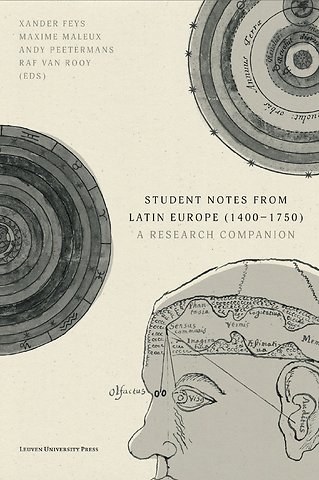Student Notes from Latin Europe (1400–1750)
A Research Companion
Paperback EN 2025 1e druk 9789462704565Samenvatting
The many preserved collections of student notes from the early modern period – ranging from neatly maintained notebooks to barely legible scribbles crammed between lines of printed text – hold considerable but largely untapped potential as an historical source. At the same time, the analysis of these notes poses significant challenges for scholars. This book aims to be a concise and accessible companion for scholars interested in engaging with this young and burgeoning research field. Written by a diverse group of specialists from across Europe and the US, it explores the various technical and practical aspects involved in reading, interpreting, and editing student notes, while also demonstrating how these sources can enrich various areas of historical research. Indeed, student notes reveal that early modern lecture halls were often more dynamic, diverse, and creative than we might have expected.
Specificaties
Thema classificatie
Lezersrecensies
Inhoudsopgave
Raf Van Rooy and Maxime Maleux, on behalf of the editors
Education in early modern Latin Europe: A scene from Leuven
Structure of the research companion
Why Leuven?
Acknowledgments
Notes
References
Part I—The Basics of Student Notes Research
Chapter 1—The Making of Student Notes
Ann M. Blair
The survival of student notes
The forms of student notes
Methods of note-taking in the classroom
What can and cannot be learned from student notes
Notes
Suggestions for further reading
References
Chapter 2—Getting a First Grasp of Student Notes
Raf Van Rooy and Xander Feys
Introduction
Referentiality, fragmentariness, and provenance
Paleography
Drawing up a typology for student notes
4.1. Form
4.2. Structure
4.3. Contents
Conclusion
Exercise
Notes
References
Transcription and model solution
Chapter 3—The Materiality of the Student Notebook
Jarrik Van Der Biest
Introduction
From paper mill to preservation
Analysis
3.1. Quire structure
3.2. Distribution of watermarks
3.3. Dates
3.4. Textual divisions, codicological blocks
Notes
Thematic bibliography
Chapter 4—Book History: The Basics with Two Case Studies
Natasha Constantinidou, Dieter Cammaerts, and Violet Soen
Introduction
An increasingly interdisciplinary field
Production and distribution of printed books
From production to consumption: An inquiry into material objects
Analyzing printed text editions: Aspects of book history in practice
Conclusions
Notes
Thematic bibliography
Chapter 5—How to Make Student Notes Accessible
Raf Van Rooy
Introduction
Choose wisely from the start
2.1. Diplomatic and semi-diplomatic transcription
2.2. XML
2.3. The act of transcribing: Benefits and tools
2.4. Good practices
Conclusion
Notes
References
Student Notes Toolkit
Part II—The Potential of Student Notes Research
Chapter 6—History of Education
Daniel Gehrt and Michael Stolberg
Introduction
The diversity and flexibility of basic academic education
Training for professional practice: Medical students’ notebooks
Conclusion
Notes
References
Chapter 7—Intellectual History
Lorenz Demey, Marc Laureys, Maxime Maleux, and Andy Peetermans
Introduction
Revolutionary rhetoric versus didactic continuity: Juvenal in Bologna
Official policies versus didactic non-conformism: The university of Leuven and the Wegestreit
Textbook canonicity versus didactic creativity
4.1. Aristotelian diagrams beyond the square of opposition
4.2. Hebrew in Leuven and Paris
Conclusion
Notes
References
Chapter 8—Book History
Xander Feys and Raf Van Rooy
Introduction
Book circulation
Interleaving for intermezzi
Student practices in handling books and their flaws
Pedagogic pragmatism
Conclusion
Notes
References
Chapter 9—Visual History
Alicja Bielak and Gwendoline de Mûelenaere
Introduction
Visual elements in notebooks
2.1. Heterogeneous visual languages
2.2. Diagrams
2.3. The materiality of the image
Classification of images in student notebooks
3.1. Traditional university iconography
3.2. Scientific drawings and engravings
3.3. Symbolic language
Emblems as didactic and mnemonic devices
4.1. Scientific emblemata
4.2. Recuperation of emblematic devices
4.3. Emblems as memory aids
Conclusion
Notes
References
Chapter 10—History of Orality
Tomás Antonio Valle and Raf Van Rooy
Introduction
Conversational culture at Wittenberg university c. 1550
The oral/aural challenges of teaching and learning
Conclusion
Notes
References
Further reading
Chapter 11—Socio-Cultural History
Maximilian Schuh, Xander Feys, and Raf Van Rooy
Introduction
Case study 1: The arts faculties at Uppsala and Ingolstadt
2.1. Uppsala
2.2. Ingolstadt
Case study 2: Triangular teaching in Milan in about 1465
Case study 3: Aeneid 12 and the Turkish threat
Conclusion
Notes
References
Multilingual Glossary
Vaak samen gekocht
Anderen die dit kochten, kochten ook
Rubrieken
- advisering
- algemeen management
- coaching en trainen
- communicatie en media
- economie
- financieel management
- inkoop en logistiek
- internet en social media
- it-management / ict
- juridisch
- leiderschap
- marketing
- mens en maatschappij
- non-profit
- ondernemen
- organisatiekunde
- personal finance
- personeelsmanagement
- persoonlijke effectiviteit
- projectmanagement
- psychologie
- reclame en verkoop
- strategisch management
- verandermanagement
- werk en loopbaan








